- Incarceration rates increasing despite declining crime rate (Pettit and Gutierrez 1153-1154).
- Disparities in incarceration of blacks, Hispanics, and youths (Pettit and Gutierrez 1153; Zaw et al. 103).
- Harmful to employment, health, neighborhood. (Pettit and Gutierrez 1155).
- Indirect consequences on family members (Beckett et al. 322).
One of such solutions is increasing the diversity of justice system employees, such as the police. A heterogeneous and diverse society is best served by a similarly diverse justice system. The arguments in favor of this approach are based on the representational bureaucracy framework. Under it, minority officers have a better understanding and stronger stakes in their communities (Todak, Huff, & James 491). Furthermore, once they become numerous enough to reach a “critical mass”, they can represent that community’s interests. Finally, since racially biased behavior and decisions are often influenced by negative stereotypes, presenting counter-stereotypical examples can be a major factor in combating these stereotypes.
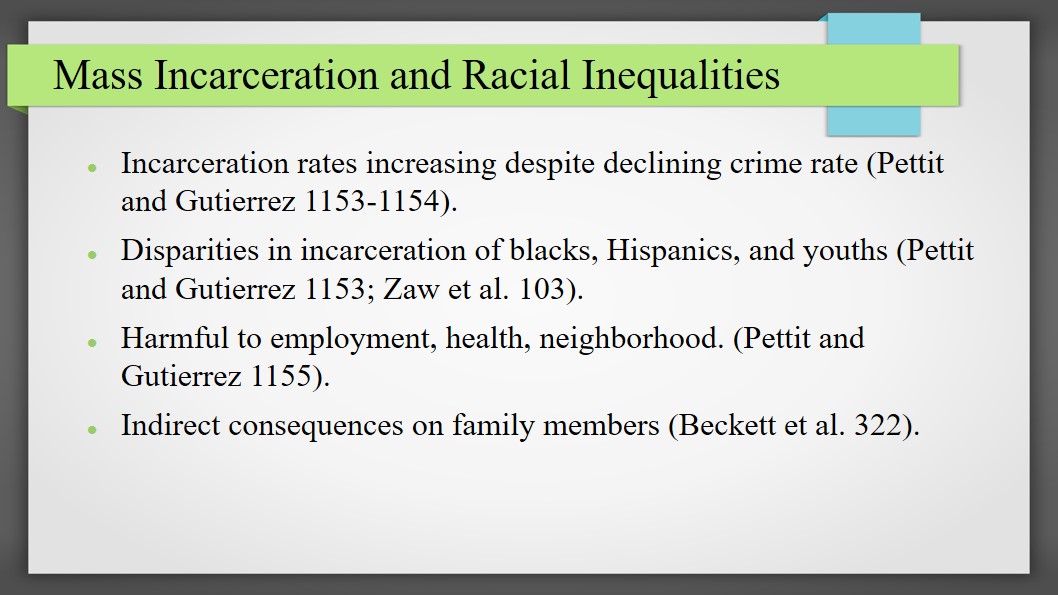
Solution 1: Increasing diversity of justice system employees
- Minority officers have stronger stakes in community (Todak, Huff, & James 491).
- With “critical mass”, they can represent community interests.
- Positive interaction combats negative stereotypes.
- Overall effect is questionable (Nicholson-Crotty et al. 213).
- Negative interactions can reinforce stereotypes.
- Minority officers may be more likely to discriminate (Nicholson-Crotty et al. 213).
- Enforce stricter standards on minority employees?
- Can be perceived as discrimination.
One of such solutions is increasing the diversity of justice system employees, such as the police. A heterogeneous and diverse society is best served by a similarly diverse justice system. The arguments in favor of this approach are based on the representational bureaucracy framework. Under it, minority officers have a better understanding and stronger stakes in their communities (Todak, Huff, & James 491). Furthermore, once they become numerous enough to reach a “critical mass”, they can represent that community’s interests. Finally, since racially biased behavior and decisions are often influenced by negative stereotypes, presenting counter-stereotypical examples can be a major factor in combating these stereotypes.
However, attempting to directly increase the diversity of police officers can have adverse effects. For instance, it can reinforce existing negative stereotypes if the new employee fails to act in a counter-stereotypical manner or otherwise meet expectations. Furthermore, some note that black officers may be more inclined to discriminate while trying to “adopt a … role that prescribes such behavior” (Nicholson-Crotty et al. 213). Therefore, these measures need to target negative stereotypes by encouraging positive intergroup interaction (Spencer et al. 55). This suggests that policies may need to enforce stricter standards on minority officers, which can be seen as a form of discrimination. Therefore, we can conclude that diversity policies are but one part of a complex solution that require deeper research to be effective.
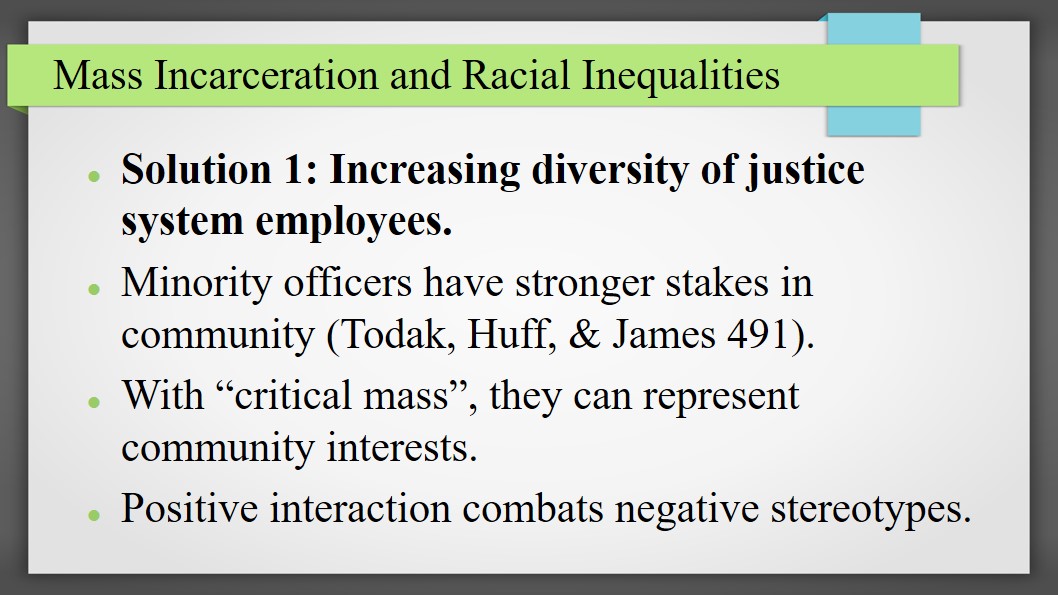
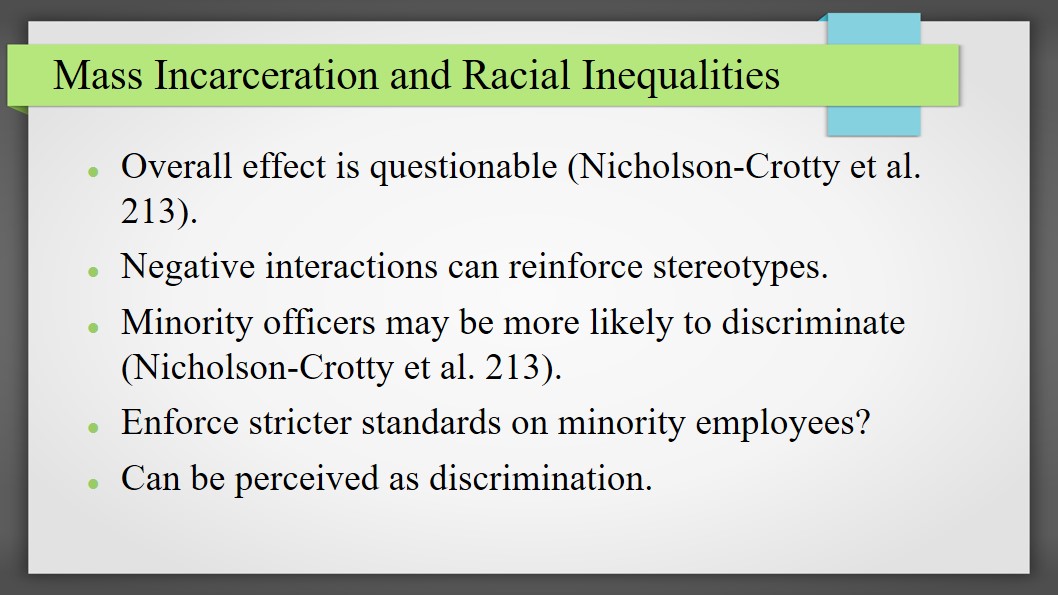
Solution 2: Alternative Correctional Programs
- Long prison sentences are proving to be ineffective.
- Racial differences in perceived severity of correctional measures (Irizarry et al. 236).
- Choosing punishment based on race?
- Other factors more important (Irizarry et al. 252).
Currently, lengthy prison sentences are used as the primary means of punitive and correctional action; however, they are proving to be ineffective at reducing recidivism. Other correctional measures exist, and racial differences have been noted in the perception of the severity of such measures (Irizarry et al. 236). Although race is one of the factors that affect these perceptions, it is not the only one: people who are married, or have children, are more likely to view prison as more a more severe punishment (Irizarry et al. 252). Ultimately, these factors can be considered, but not in a discriminatory way such as choosing a suspects’ punishment based on his or her race.
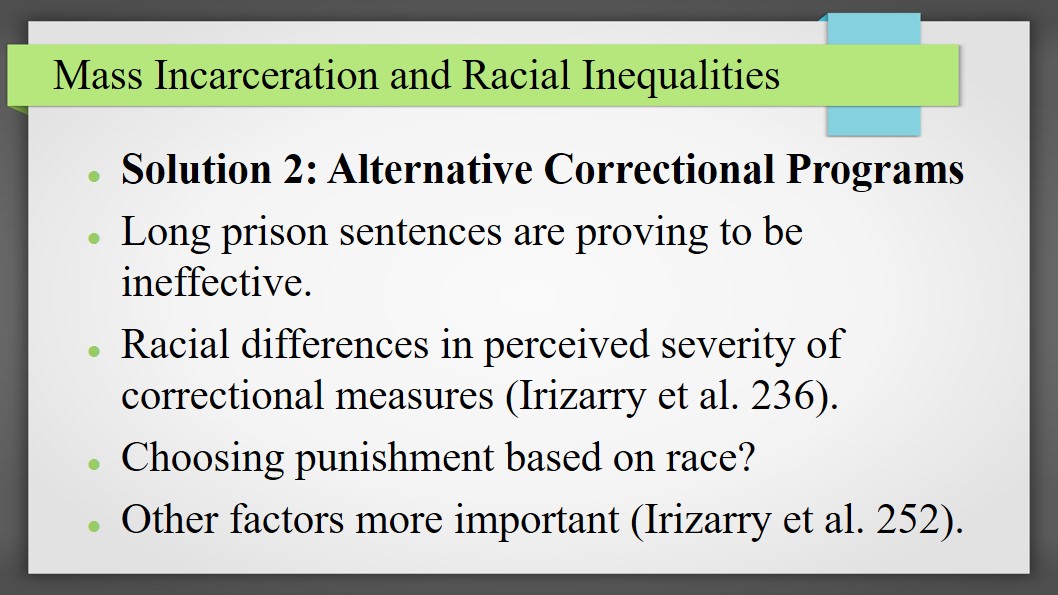
School-to-prison pipeline
- Criminogenic conditions in the school system (Vitale 56; Walker et al. 6).
- Harsh police intervention for minor infractions, weak evidence (Vitale 56-57).
- Underlying causes for youth criminal behavior can be targeted (Vitale 57).
- Requires significant and costly reforms (Vitale 74).
Another major factor that contributes to mass incarceration is sometimes referred to as the school-to-prison pipeline. The current school system is overreliant on test scores for funding, and employs zero-tolerance policies for minor infractions (Vitale 56-58). Coupled with increasing police presence in schools, this creates an oppressive, prison-like atmosphere, and encourages educators to remove failing students through expulsions or even arrests (Vitale 56-74). This harms the students’ further education and employment options, while doing nothing to address the underlying social and psychological causes of criminal behavior (Vitale 74). Programs that target these causes have been attempted, and demonstrated positive effects, but fully implementing them would require long-term and costly reforms (Vitale 71-74).
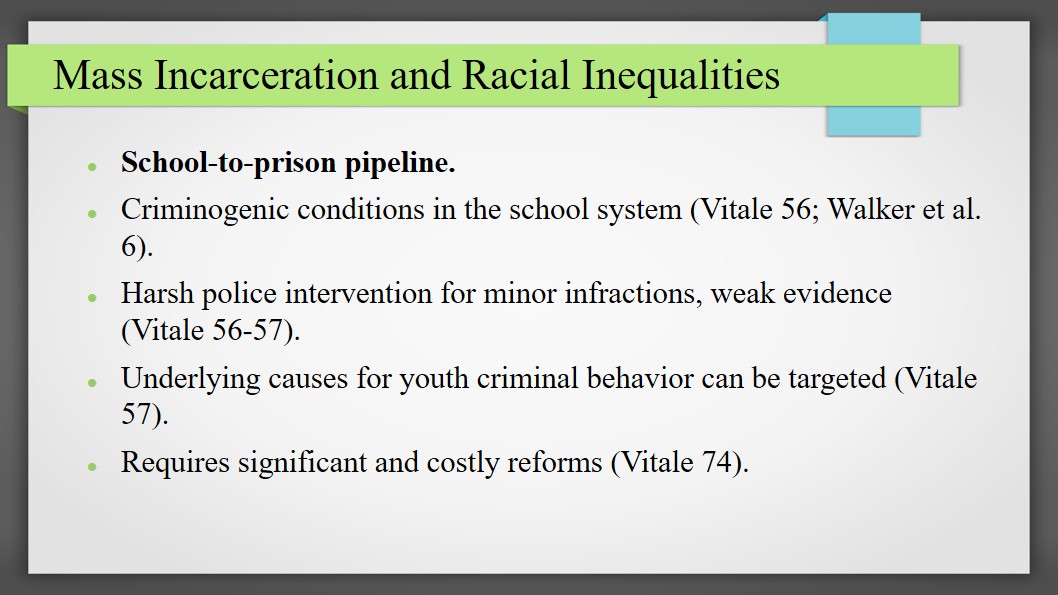
Improved training and control
- Police affected by implicit racial bias, causing discrimination (Spencer et al. 51).
- Training programs show inconsistent results (Spencer et al. 55-56).
- Can sometimes cause adverse effects (Spencer et al. 55).
- Difficult to measure effectiveness.
When discussing racial disparities, one cannot ignore implicit biases that affect justice system employees as much as any other person. Institutions have been trying to control these biases by implementing a variety of cultural sensitivity or diversity training programs. However, the outcomes of these programs are inconsistent, and although in some cases they can reduce discriminatory behavior, in others, they can have an adverse effect (Spencer et al., 55-56). Measuring or predicting the effectiveness of such programs is difficult or impossible due to the nature of stereotypes and implicit biases. Overall, while this type of training can be effective, it is not necessarily sufficient by itself. Furthermore, the inconsistent results suggest that significant research is necessary to implement such measures with consistent success.
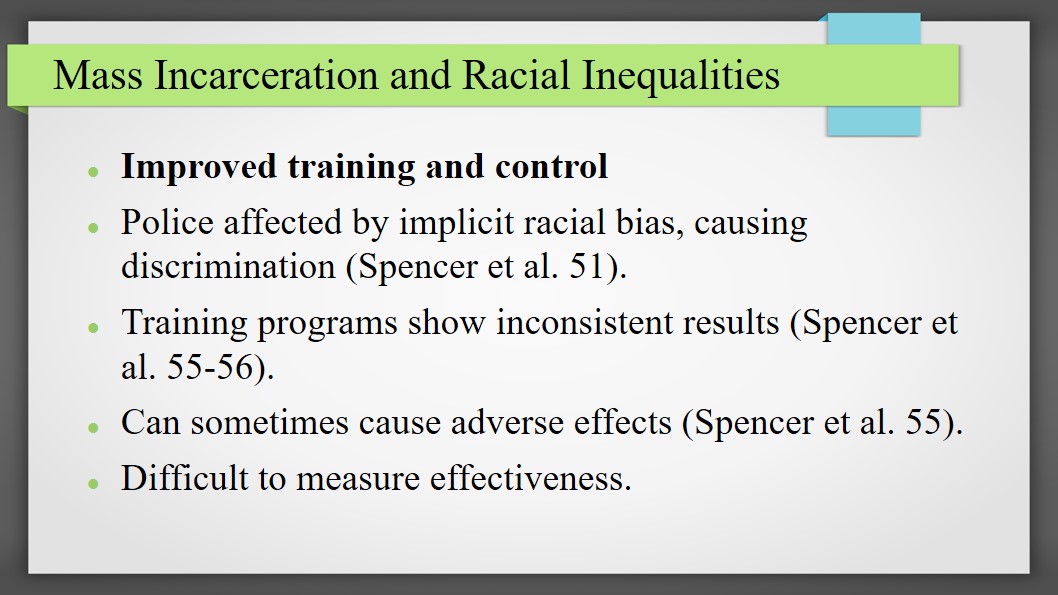
Reducing individual discretion via stricter rules
- Shows positive results, improves outcomes (Spencer et al. 59).
- Increases police accountability and oversight (Ready and Young 454).
- Allows leveraging new technology.
- Prevents officers from acting on biases.
Finally, discriminatory behavior can be addressed directly by implementing and enforcing stricter rules that reduce an individual’s discretion in handling situations. Such rules can restrict the requirements to conduct searches, which has caused a significant reduction in false-positive searches and racial disparities in the process in at least one case (Spencer et al. 59). Additionally, policy changes can leverage modern technological innovations to improve outcomes. Implementing on-officer video cameras has, for instance, greatly increased police oversight and accountability as any claims can be verified by video evidence (Ready and Young 447). Although these measures do not affect stereotypes or biases directly, they prevent officers from acting on them.
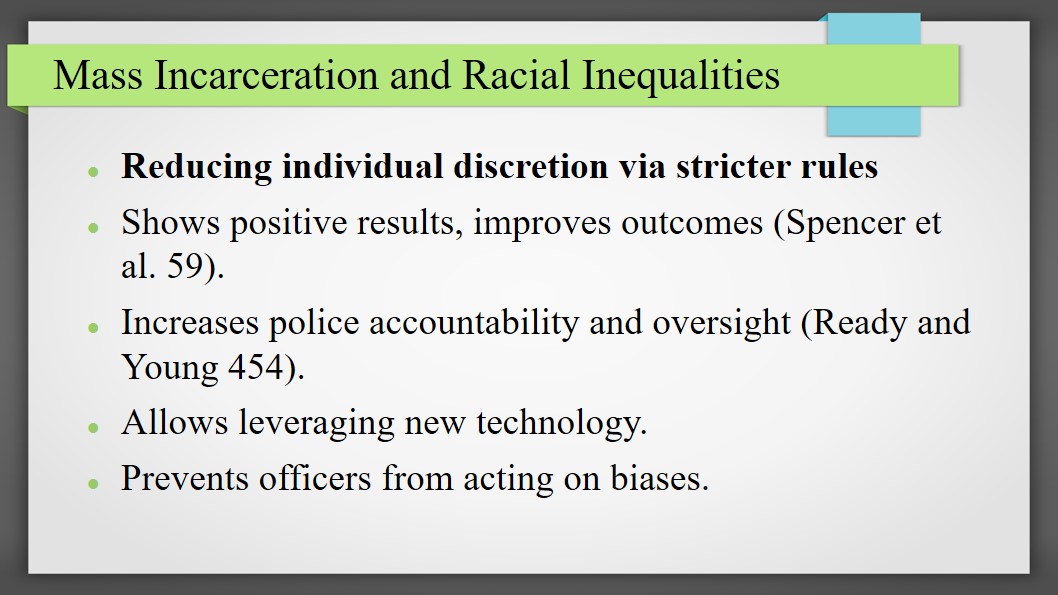
To summarize
- Reforms to school system can reduce incarceration.
- Directly increasing diversity: a secondary goal.
- Training has inconsistent results, needs research.
- Improved control and leveraging technology brings direct improvements.
To summarize: mass incarceration and racial inequalities are still major issues in the modern United States, and part of broader problems with the justice system in general. Such broad and deep-reaching problems require a complex and long-term approach to solve. A solution will, therefore, likely contain elements from all three of the examined methods. However, the primary goal should be implementing reforms not to the justice system, but to the school system, as that is where a significant part of the criminalization of youth originates. Increasing the justice system’s diversity and implementing counter-stereotype training should be approached with care, as they can have unpredictable and adverse effects. Finally, stricter controls and the leveraging of modern technology have to be used for a more immediate reduction of disparities.
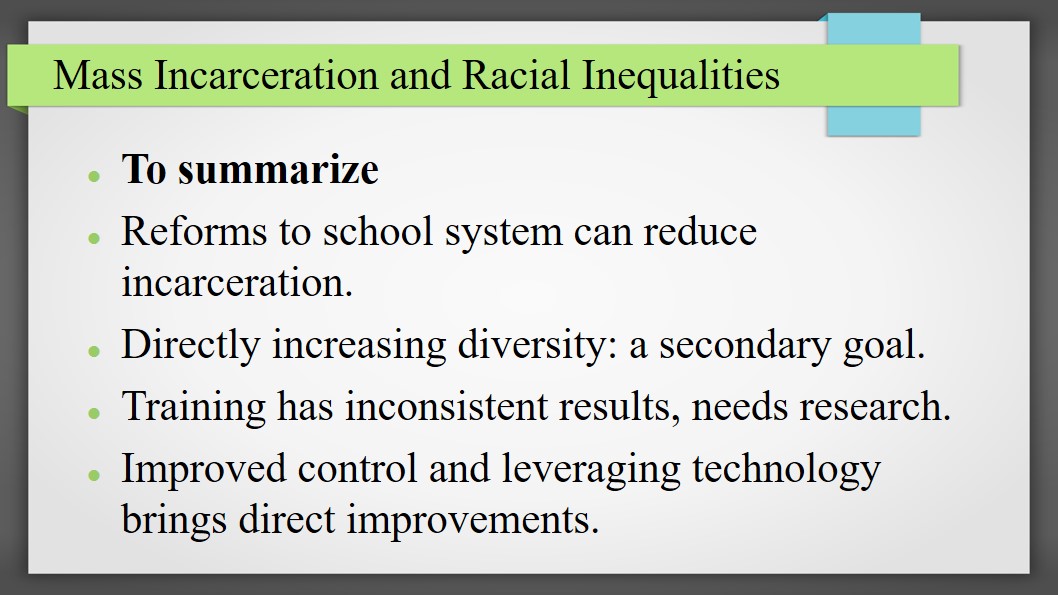
Works Cited
Beckett, Katherine, et al. “US Criminal Justice Policy and Practice in the Twenty-First Century: Toward the End of Mass Incarceration?” Law & Policy, vol. 40, no. 4, 2018, pp. 321-345. Web.
Irizarry, Yasmin, et al. “Mass Incarceration Through a Different Lens.” Race and Justice, vol. 6, no. 33, 2015, pp. 236-256. Web.
Nicholson-Crotty, Sean, et al. “Will More Black Cops Matter? Officer Race and Police-Involved Homicides of Black Citizens.” Public Administration Review, vol. 77, no. 2, 2017, pp 206-216.
Pettit, Becky, and Carmen Gutierrez. “Mass Incarceration and Racial Inequality.” American Journal of Economics and Sociology, vol. 77, no. 3-4, 2018, pp. 1153-1182.
Ready, Justin T., and Jacob T. N. Young. “The Impact of on-Officer Video Cameras on Police–citizen Contacts: Findings from a Controlled Experiment in Mesa, AZ.” Journal of Experimental Criminology, vol. 11, no. 3, 2015, pp. 445-45.
Spencer, Katherine. B., et al. “Implicit Bias and Policing.” Social and Personality Psychology Compass, vol. 10, no. 1, 2016, pp. 50-63. Web.
Todak, Natalie, et al. “Investigating Perceptions of Race and Ethnic Diversity among Prospective Police Officers.” Police Practice and Research, vol. 19, no. 5, 2018, pp. 490–504. Web.
Vitale, Alex S. The End of Policing. Verso, 2017.
Walker, Samuel, et al. The Color of Justice: Race, Ethnicity, and Crime in America. 6th ed., Cengage Learning, 2018.
Zaw, Khaing, et al. “Race, Wealth and Incarceration: Results from the National Longitudinal Survey of Youth.” Race and Social Problems, vol. 8, no. 1, 2016, pp. 103-115. Web.